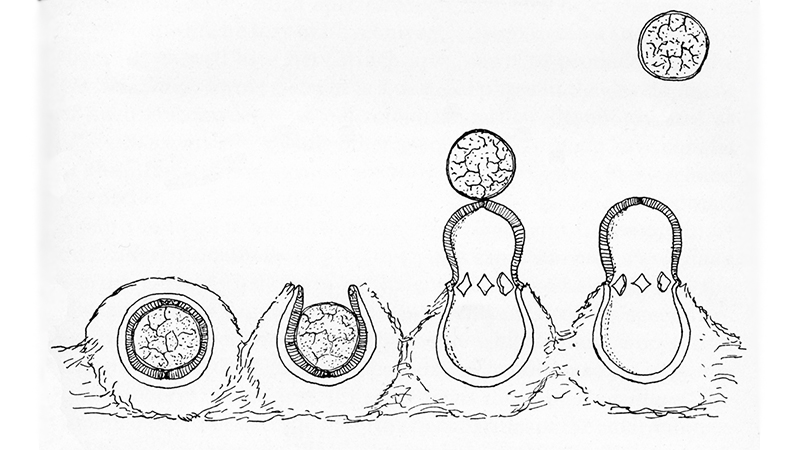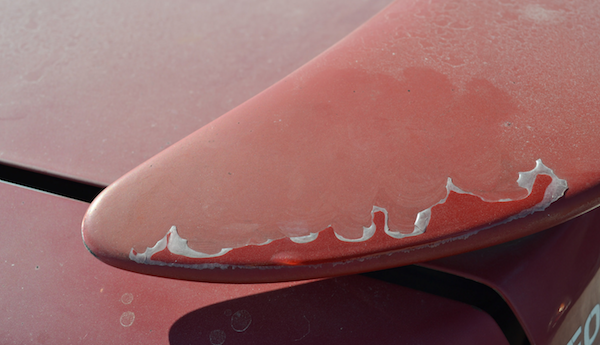Call it sphaerobolus (from the family Geastracae), shotgun fungus, fly-speck fungus, cannonball fungus or artillery fungus, it's all the same — it's a nasty brand of fungus that comes from wood mulch and similar environments. Artillery fungus is so named because when it discharges spores, they can travel as much as six feet vertically and 20 feet horizontally, and the spores cling like grim death to whatever surface they land on. The longer they're there, the more difficult they are to remove. Even the genus name is Greek for "sphere thrower."
The spores are about 1/10 of an inch in size, and when they're discharged, the wind can pick them up and carry them even farther. They then emit a substance that's as sticky as Super Glue, and adheres to wherever they land. They thrive in sunlight, and when sunlight isn't available they can tend to cling to light-colored surfaces, including light-colored sidings on houses and... cars.
So, how do you get rid of artillery fungus? Read on.
Problems with Artillery Fungus
Often, artillery fungus is mistaken for tree sap since the vehicle was parked near a tree and the stuff is tough to remove. Really, really tough to remove. On house siding, people try everything from bleach to pressure washers to steel wool and sandpaper, with mixed results.
When it comes to cars, a pressure washer might work, but the blast of high-pressure water and soap can be enough to fracture the clear coat on a finish. On an older vehicle, it can be enough to ruin clear coat or even strip chunks of paint off from underneath. Not good!
Worst of all, even if you manage to remove the dots of fungus you can be left with a brown stain on the finish that's even harder to get rid of. Something that's abrasive like rubbing compound can sometimes dislodge this stuff, but then you're left with the prospect of possibly leaving swirl marks or scratching the paint.
How to Safely Remove Artillery Fungus
- Plastic razor blades are handy for going after the sticky residue of old bumper stickers or scraping an inspection sticker off the inside of a windshield. They're also useful for removing artillery fungus, road tar or bug carcasses without damaging the finish, but it's a pretty tedious and labor-intensive job. Hold the blade at about a 45-degree angle and scrape carefully, taking care to not let it dig into the paint or clear coat.
- Some have reported good results with Turtle Wax Bug & Tar Remover, provided the fungus hasn't been on your finish long enough to really take hold. The combination of chemicals in this Turtle Wax product is enough to break up the stuff and allow it to be removed; it's formulated to dissolve stubborn bug carcasses and road tar without damaging your finish.
- Ever used Goo Gone for household cleaning projects? Maybe in the kitchen, on the fridge or in the bathroom when you need to remove stuff that's sticky, gunky or greasy? Automotive Goo Gone is great for removing sticker residue and road tar; its effectiveness on fungus will probably depend on how long the fungus has been on the vehicle's finish.
- Clay bar systems can be effective, but again we're talking about an abrasive that can leave scratches and marks in the paint as it picks up contaminants, so you really need to be careful. Clay bars have been a favorite of detailers for a long time, but there's a trick to using them. First, make sure your car's been washed and is completely dry. You should break your bar into three or four pieces and flatten out a piece to about three inches across; use a liberal amount of clay lubricant before you go to work with it. Work on about a two-by-two-foot area at a time, being sure to only direct the clay bar in one direction rather than back and forth or in circles. Keep kneading and folding the clay so that you've always got a fresh surface; if you drop it on the ground, get a fresh piece and start over.
Anecdotal remedies
It's reported that white vinegar can be effective in removing sap or artillery fungus. Lots of people use strong white vinegar as a cleaning agent around the house — its acidity can disinfect and clean hard surfaces. With that in mind, it could conceivably break down artillery fungus and make it ready for removal, making it a great chemical alternative that shouldn't damage finishes or be dangerous to handle. If you use white vinegar, you might consider diluting it a bit, and always be sure to rinse it off right away with clean water.
Others report good outcomes using Formula 409 or Windex as well as various bug and tar removers, although a considerable amount of elbow grease will probably also be needed. You can try a plastic kitchen scrubbing pad (be careful), microfiber towels or an old-fashioned Turkish towel with these products. Some have mentioned the brown stains coming back some time after the fungus has been removed; if that's the case, the fungus may have impregnated its way down into the finish.
Maybe the best approach? Prevent the stuff from sticking by applying a few coats of a good quality wax and then applying wax monthly after that. Wax protects your car's finish from not just mold and spores, but also helps prevent damage from rocks, chips, the sun's UV rays and road debris.
Finally, since artillery fungus loves to live in landscaping wood chips and mulch, you might consider replacing any mulch at your house with decorative gravel or another material that won't support fungus.
Have you come across artillery fungus before? How did you remove it from your vehicle?












